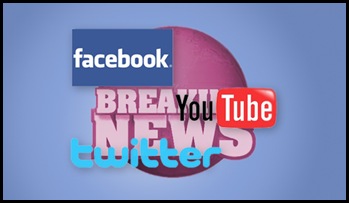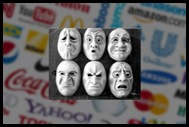 What is spoken about here is the ‘hard to define’ nature of emotional connection of brands. How brand managers can think of ways to strengthen the connection between their brand and the target market. Also a light is thrown upon what some of the reputed brands have done with the emotion of content & tone. Moving further the statistics in this context bring in some awareness to this element too.
What is spoken about here is the ‘hard to define’ nature of emotional connection of brands. How brand managers can think of ways to strengthen the connection between their brand and the target market. Also a light is thrown upon what some of the reputed brands have done with the emotion of content & tone. Moving further the statistics in this context bring in some awareness to this element too.
Behavioral psychologists have long argued that only 30% of human decisions and behaviors are actually driven by rational considerations. This means that more than 70% of consumer loyalty and spending decisions are based on emotional factors. And it’s these emotional experiences that create connected, passionate, engaged customers.
Therefore, Emotional Connection = Engagement.
Engagement is based on emotional attachment between the customer & brand that develops and endures over time. The more frequently and consistently a brand can connect with a customer on an emotional level, the stronger and deeper the customer becomes engaged with the brand. One of the key factors for forging a meaningful, emotional relationship with customers is the brand‘s ability to integrate into their lifestyles. Brand becomes relevant in the customer’s life when this is achieved. Foundation of the brand-customer relationship becomes one built on loyalty, relevance & dependability.
Every ad generates an emotional response. Emotional responses constructed through a strong content are hard-wired into our brains and essential to our survival. Familiar & pleasurable ads generate more attention and attract us, while painful or threatening ones repel us. Emotional connection is a powerful way to link the heart of your target market with the soul of your brand.
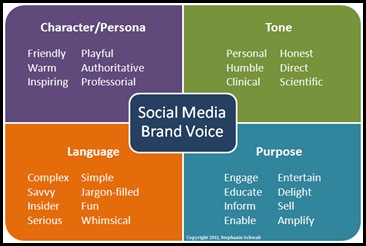
Image Courtesy: http://www.socialmediaexplorer.com/social-media-marketing/finding-your-brand-voice/
We, as activators of our clients’ brands should:
Strategically let them think over two questions:
(a) Which emotion can they own?
(b) How much emotional intensity does their category and brand merit?
Both answers are defined and limited by the target market.
But within those limits, you can tailor almost every business decision you make to maximize the appropriate emotional connection.
We respond emotionally to everything!
Emotion in Advertising is Pervasive, Yet Misunderstood. Advertisers talk about importance of generating an emotional response from people. However, they rarely stop to specify exactly what characterizes such a response or why they believe it is important.
The subject of emotion in advertising tends to bring certain types of commercials to mind! Does any commercial come to your mind?
Lately, you all must have come across popular brands and the ads where emotion in the content was given a great importance.
Coca Cola- Haan Haan Main Crazy Hun
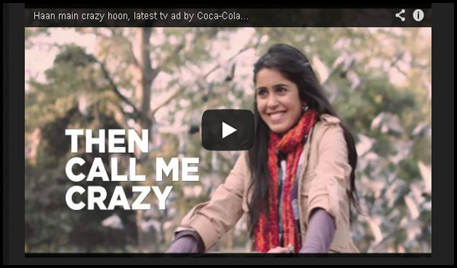
Click here to watch the complete ad
Coca Cola
• The theme of the ad is "Open happiness", which is a very good concept and surely a need of the time.
• It can change the mood of a person and help him/her relax, have a laugh & forget tensions for the moment.
• Ad comes as a beautiful surprise and might even inspire someone to do some crazy but useful act.
• The acts designed are from our day to day life.
• The tone is that of today’s people, they keep talking about dude this is crazy….dude she is crazy, so coca cola took that insight & made the copy.
• The positive associations also work to create a brand that is loved.
Creativity/Freshness:
• Unique in concept.
• Focus on spreading love & happiness.
• Fresh idea to share happiness even with strangers.
Coca Cola always comes out with something unique in its concept; however their campaign always focuses on spreading love and happiness. This advertisement is also creative in its own natural way as every character in this TVC is trying to shower happiness/ kindness through any means. So its kind of something fresh idea to share your happiness even with strangers.
Emotional Connect:
• Acts of kindness by feeding the dog, giving a bottle of coca cola build an emotional connect.
• Emotional connect is high as it shows how one gets peace by helping others or by making them happy.
It is at par in this TVC as one character is feeding stray dogs and other tries to make security guard happy by giving him a bottle of coca cola. Emotional connect is high as it is showing the height of peace you get when you make other person happy.
Brand Association:
Revolve around brand value & keep brand association intact.
Coca Cola beverages always revolve around its so strongly created brand value. It has featured its beverages bottles with highlighting the name Coca cola and thus brand association is kept intact.
Relevance:
• Relevance of this TVC lies in the fact that Coca cola always impart happiness through its campaign.
• This ad also paved on the same path with a new motto of spreading happiness in your own crazy ways.
Relevance of this TVC lies in the fact as Coca cola always try to impart happiness through its campaign, this advertisement is also paving on the same path with a new motto of spreading happiness in your own crazy ways. However, spreading happiness through a bottle of soft drink doesn’t make much sense to me still the picturization was so apt that it forces you to believe it.
Segmentation: This TVC has segmented people of all the categories still youth is the main center of attraction in it as there is nothing wrong if I say that youth are the main consumers of coca cola in India.
Pepsi- Oh! Yes, Abhi

To check what Pepsi is doing on Twitter, click here
Pepsi Facebook Page




Click here for an amazing website view

Pepsi’s new campaign & positioning: ‘Oh yes Abhi’
• Harping on the youth’s impatience & the need to do everything ‘right now’, the campaign reinforced the concept of living in the moment.
• Oh Yes Abhi! Translates into – live for the present as tomorrow is too late.
• Young people, they want things quick. Fast. Now. Hence the copy, Oh yes abhi.
• The campaign is a great combination of impatience of the cola & impatience of youth presented in a grand manner.
• Digital media like facebook, twitter, websites have also been used to promote the campaign.
Do you Recall these positioning of PEPSI?
‘Nothing official about it’ (1996)
‘Yeh dil maange more!’ (2006)
‘Pepsi ye pyaas heh badi’(2000)
‘My Pepsi My Way’(2009)
‘Change the game’ (2011)
‘Oh Yes Abhi’ (2013)
iPhone

"If you don’t have an iPhone, well, you don’t have an iPhone“
• With this tone and content, the commercials then launch into a quick overview of key iPhone features.
• With the voiceover explaining the stuff you’re unable to do unless you’re a proud iPhone owner.
• People who carry apple product perceive themselves as above others.
• Hence the copy, if don’t have an iphone, well you don’t have an iphone.
• It is very important to understand the emotion of the copy. It should tie up with the brand personality audience and emotion.
Kit Kat- Dancing Babies

Click here to view
• Nestle’s new campaign urges people to take a break from their busy & hectic lifestyles & get surprised by some delightful moments in life.
• Their brand message, “Good things happen when you take a break”, the ad demonstrates that taking a few minutes to enjoy a Kit Kat can bring an unexpected & adorable delight to your day.
• Known for its youthful appeal, Kit Kat brought in smiling, giggling, singing & dancing Babies.
• They took babies as watching babies play puts a smile on anyone’s face. Watching them doing something we haven’t seen before is really great.
• Shows how taking a Kit Kat Break helps you notice something good which you might have otherwise missed.
Idea- Honey Bunny
How can we forget this “Honey Bunny”? Click here to view the ad

• Idea Cellular’s advertising has cut a wide arc, going from ‘What an Idea, Sirji!’ to “You’re my pumpkin pumpkin, hello honey bunny”.
• This jingle is on everyone’s lips, having become quite a rage across the country, just as the earlier campaign became a big success.
• Idea’s new ad campaign- ‘Idea Rings All India’ was launched after this teaser jingle.
• “Music is something which is universal, something which blends with every culture. It’s a hummable, likeable song, and that was exactly the thought behind creating the jingle.
• It went viral and was popular across the nation, on all platforms too.
ICICI Bank- Bande Achche Hain

• From concept to brand communication to creative execution, ICICI’s new ad campaign is a hit.
Campaign name: Bande achhe hain (They are good men)!
• Various situations are shown displaying caring nature of a family man, primarily as a husband and a father, who keeps fulfilling his responsibilities towards his family without really making a big deal about it.
• The tone of the TVC is that while men may be a little childish in their carelessness and forgetfulness, they’re a loving, responsible and caring still.
• The catchphrase in the background score is “Par bande achhe hain” (But they are good men).
• The ad ends with the voice-over: “Jo zimmedari nibhaate hain, jataate nahi. Unko suraksha dete hain hum. ICICI Prudential Life Insurance. Zimmedaari ka humsafar”
• In a nutshell,
• The ad is relevant with a feel of family, their care etc. & hence accepted happily.
• A unique representation of an insurance ad.
• The song, the message, concept & the way real life situation and care is depicted is amazing.
Overall: The ad is Best in Class, Good Impressive and Appealing.
7Up – I Feel Up

View ad

View ad
• They used rhythm & unexpected choreography to enliven the mood.
• It is an extension of the ‘I feel up’ thought where quirky dance & music combination is shown.
• A Kathakali artist dance.
• Japanese woman in the station performing lavani .
• Highlighted the two most important equity properties as ‘dance’ and the ‘I feel up’ optimism, which the brand stood for.
• It was not much about the dance, but about joy & happiness that drives true ‘uninhibitedness’ through dance.
‘I feel up’ message resonated with one’s mind & communicated that 7Up livens up a break in the middle of a dreary boring day.
Cinthol – Alive is Awesome

• Cinthol in order to reposition itself came up with a fresh campaign.
• The new idea they hit upon with was – “Being Alive is Awesome”!
• Targeted at younger consumers who want to live their life to the fullest.
• Cinthol tried to squeeze itself in the entire scheme of things representing the brand essence of a very active lifestyle.
• They tried to relate to the new generation and successfully related to what the people of today want, think & aspire – to live their life, freely etc.
Just have a look at the Facebook page of Cinthol. Don’t miss the amazing video ad that enticed a lot of viewers who not only enjoyed the ad but could also relate to the tone and content of the brand. They also launched a YouTube app for this campaign.
The After effects of using Emotions in brand content
Real challenge is to focus people’s attention. If an ad is going to evoke a response that will last longer than a few seconds, it must create a memorable feeling. It must create a virtual magnifying glass that highlights something specific in relation to the brand — some fact, idea, or impression — and give it enough emotional charge to become established in memory. The response can be positive or negative, intense or weak. Response may not be intensely positive or intensely negative, it is still “emotional.” Product satisfaction is the biggest driver of emotional response. 
Not all brands have the “right” to communicate messages implicitly through emotionally arousing content; that is a privilege that is earned over time. Brands spend decades building a connection. Example: Coke. Newer brands need to focus on establishing their functional credentials even when their ultimate intent is to “ladder up” to an emotional benefit.
We need to also believe that the choices are justified by reason, not just feelings. If all advertising generates an emotional response of some sort, the real question then becomes whether an advertisement will evoke any conscious thought.
What about the use of emotional content, context & tone in Social Media?
Well, this is a very important question because as social media is becoming the most integral element of the marketing strategies then its clearly evident that emotion and content of a brand will lay a great impact on the consumers online. And most importantly the response would be quicker than any other medium and results would be surprising. Therefore, brand managers should integrate this concept in social media too.
Maslow’s Hierarchy of needs explains this concept best.
Expectations
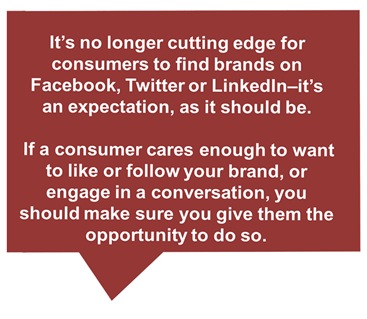
Desires
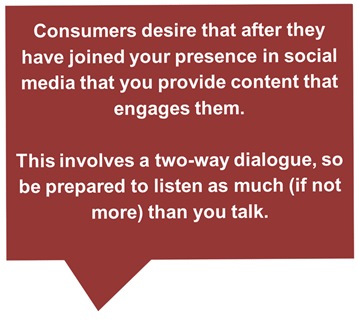
Unrecognized Needs
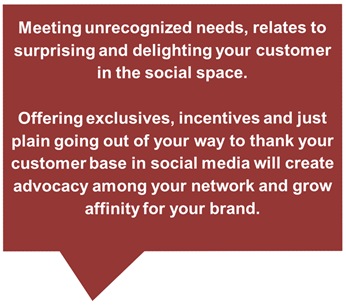
Finding the tone of voice in SMM
Authenticity = self awareness x courage
To understand one’s self and have the confidence to be true to your human nature takes courage. Amplify both and you get authenticity.
Now the question is are you ready for a deeper dive into your business?
If yes, then there are a few questions that when answered help brands to dive deeper and understand the brand tone & content they can use in their SMM and to connect to a customer in a deeper emotional level.
The three questions for testing authenticity are:
1. What business are we in?
2. What courageous, rebellious decisions have we recently made that could be perceived as brilliant or foolish?
3. What would it mean to the world if we didn’t exist anymore?
Irrespective of the desired response to advertising, don’t you think the first step is to create a link in consumers’ minds between the memories left by the ad and the brand? Shouldn’t an ad focus attention on the brand and the desired impression at the time of viewing? Customer engagement is all about emotional connections which have proven to be powerful and profitable. Lets see what is in store for brands in future and what reactions it generates.
![clip_image002[6] clip_image002[6]](https://windchimes.co.in/blog/wp-content/uploads/2015/08/clip_image0026_thumb2.jpg) When was the last time you watched a television commercial without cursing the show you are watching for making you go through it? Cannot recall? We guessed so. Now, let’s take YouTube. For short videos on YouTube, it is easier to anticipate when exactly an ad is getting over and whether or not it would pop up again. Things like this influence people’s choice of the platform they want to watch your ads at. The platform of broadcasting your video advertisements is important, but a perfect combination of timing and content is the key here.
When was the last time you watched a television commercial without cursing the show you are watching for making you go through it? Cannot recall? We guessed so. Now, let’s take YouTube. For short videos on YouTube, it is easier to anticipate when exactly an ad is getting over and whether or not it would pop up again. Things like this influence people’s choice of the platform they want to watch your ads at. The platform of broadcasting your video advertisements is important, but a perfect combination of timing and content is the key here. It all comes down to the timing and content of the advertisements. Once you have uploaded your advertisement on YouTube, you can sit back and relax to see it getting circulated. It’s all about building a beautiful and strong story, and giving people sufficient time, not too much, not too less, to watch and appreciate it. When you force your advertisements on the viewers, you force them to repel it. Online shopping websites, which bank a lot on social media, are also focusing on online ads. The ad titled as ‘The Visit’, by Myntra gained more than 2 Lakh hits within 10 days.
It all comes down to the timing and content of the advertisements. Once you have uploaded your advertisement on YouTube, you can sit back and relax to see it getting circulated. It’s all about building a beautiful and strong story, and giving people sufficient time, not too much, not too less, to watch and appreciate it. When you force your advertisements on the viewers, you force them to repel it. Online shopping websites, which bank a lot on social media, are also focusing on online ads. The ad titled as ‘The Visit’, by Myntra gained more than 2 Lakh hits within 10 days.




